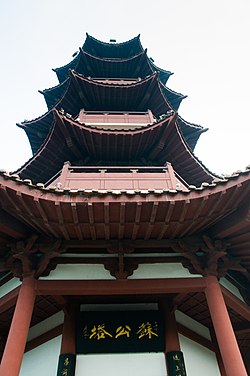Hsuchow
|
Xuzhou 徐州市 |
|
|---|---|
| Prefecture-level city | |

The skyline of Xuzhou and Yunlong Lake (云龙湖)
|
|
 Location of Xuzhou City jurisdiction in Jiangsu |
|
| Location in China | |
| Coordinates: 34°16′N 117°13′E / 34.26°N 117.21°ECoordinates: 34°16′N 117°13′E / 34.26°N 117.21°E | |
| Country | China |
| Province | Jiangsu |
| County-level divisions | 10 |
| Township-level divisions | 161 |
| Government | |
| • Mayor | Zhou Tiegen (周铁根) |
| • CPC Committee Secretary | Zhang Guohua (张国华) |
| Area | |
| • Prefecture-level city | 11,259 km2 (4,347 sq mi) |
| • Urban | 3,037 km2 (1,173 sq mi) |
| • Metro | 2,347 km2 (906 sq mi) |
| Population (2010 census) | |
| • Prefecture-level city | 8,577,225 |
| • Density | 760/km2 (2,000/sq mi) |
| • Urban | 3,053,778 |
| • Urban density | 1,000/km2 (2,600/sq mi) |
| • Metro | 2,623,066 |
| • Metro density | 1,100/km2 (2,900/sq mi) |
| Time zone | China Standard (UTC+8) |
| Postal code | 221000(Urban center), 221000, 221000, 221000(Other areas) |
| Area code(s) | 0516 |
| GDP | ¥ 532 billion (2015) |
| GDP per capita | ¥ 62,000 (2015) |
| Major Nationalities | Han |
| Licence plate prefixes | 苏C |
| Website | xz |
| Xuzhou | |||||||||

"Xuzhou", as written in Chinese
|
|||||||||
| Chinese | 徐州 | ||||||||
|---|---|---|---|---|---|---|---|---|---|
| Postal | Suchow | ||||||||
|
|||||||||
| Pengcheng | |||||||||
| Chinese | 彭城 | ||||||||
|
|||||||||
| Transcriptions | |
|---|---|
| Standard Mandarin | |
| Hanyu Pinyin | Xúzhōu |
| Wade–Giles | Hsu2-chou1 |
| Transcriptions | |
|---|---|
| Standard Mandarin | |
| Hanyu Pinyin | Péngchéng |
Xuzhou, known as Pengcheng in ancient times, is a major city in and the fourth largest prefecture-level city of Jiangsu Province, China. Its population was 8,577,225 at the 2010 census whom 2,623,066 lived in the built-up (or metro) area made of Quanshan, Gulou, Yunlong and Tongshan districts. It is known for its role as a transportation hub in northwestern Jiangsu, as it has expressways and railway links connecting directly to the provinces of Henan and Shandong, the neighboring port city of Lianyungang, as well as the economic hub Shanghai.
Before the adoption of Hanyu Pinyin, the city's name was typically romanized as Suchow or Süchow, though it also appeared as Siu Tcheou [Fou], Hsu-chou, Hsuchow, and Hsü-chow.
The early prehistoric relics around Xuzhou are classified as Dawenkou culture system. Liulin (劉林) site together with Dadunzi (大墩子) site, Huating (花廳) site, and Liangwangcheng (梁王城) site correspond to the initial, middle and late stages of this culture, respectively. While the remains of sacrificial rituals performed to Tudi deity found at Qiuwan (丘灣) site and Gaohuangmiao (高皇廟) site, both of them are in the outskirts of the city, indicate that Shang dynasty affected the area. History relates that Peng or Great Peng, the transitions from a tribe to a chiefdom contained within the boundary of the city. Peng Zu is believed to be the first chief, while the state was eventually conquered by King Wu Ding of Shang in around 1208 BC..
During the Western Zhou, a chiefdom called Xuyi or Xu rose and controlled the Lower Yellow River Valley. Allied with Huaiyi, Xuyi fought against Zhou and its vassals at irregular intervals. Since its declining, Xuyi once moved the capital to the area of Xuzhou and populated it with people who were migrated southwards.
...
Wikipedia

